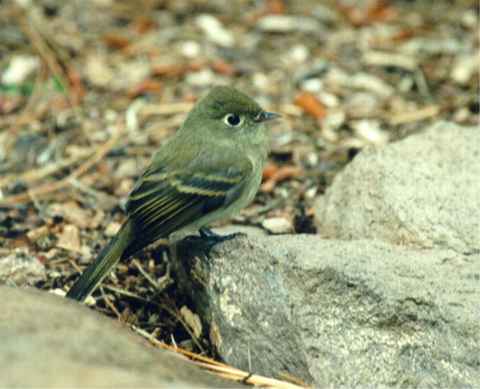

Arizona Wild Bird Photos
IN NO WHERE DESERT ARIZONA
August 11/2002 Sun up till after dark about 8:30 P.M.
At 5:30 AM it 68 degrees.
At 8:00 AM it was 99 degrees.
By noon it was 112 degrees.
At 2:30 it was 116 degrees after that I stop looking at thermometer.
*************************************************

By putting rocks al around the water opening in these founts I find it keeps the desert critters from scratching the dirt into the water area. After getting a drink this squirrel would then run over the seed tray on your right--- |

Jump straight up some 4 1/2 feet and eat the goodies from here. I have stop put so much food on the ground because they can eat as much as you put out. Example- I put put a 30 pound container of seed one evening, the morning it was empty. All though most of it had been scratched out onto the ground I think some was eaten. Within the 24 hours all was cleaned up. But 30 pounds a day, a bit much if you ask me. The Squirrels and the Black-tailed jacks are getting to much to eat. I was given 25 pounds of peanuts in the shell, within 4 hours all had been carried off by those pesky little critters. I watched where they went. took a stick and probed their holes and sure enough there was all of the peanuts. Their burrows were chucked full of peanuts. |
********************************************

These birds (Curved-billed Thrasher) are either coming out of a molt or just going into one. They are much more skinny or Gaunt than when I first viewed them a few months ago. |
 |
*************************************************

You have to admit this Shrike looks pretty bad. |
***********************************************

The Black-throated Sparrows seem to be getting along OK. They live on the seeds from the wild plants when mine runs out. However they do come to drink a lot. |
***********************************************
A few months ago this bird looked to be at least twice as big as it does in these photos.
 |
 |

Yellow - or Red shafted Northern Flicker. **************************************** On Feb. 28, 2004 OK, here is what my friend R.J. and fellow birder has written me. Also for August 11, 2002, under Gaunt Birds, you have three shots of a flicker. You ask Yellow-shafted or Red-shafted? Actually it's neither. It's a female Gilded Flicker |
************************************
 As I had said earlier, I put put out quite a few meal worms. This Gila Woodpecker had a nest of young a few hundred feet away and would carry one worm at a time to its cavity nest in a Saguaro and feed it to one its young. A bout every 5th. or 6th. time it would a few meal worms and peck at the oranges. |
***************************************

This I believe is a Western Wiptail Lizard. It came about ever 30 to 45 minutes to drink from one of the water founts. |
************************************************
I have one other bird photo to put on but do not want until I get it identified.
I believe it or would be a most unusual and rare bird to found in this location.
So, as soon as I get identified I put if on line for to see.
Well, I have it ID'ed by several qualified birders so here it is.
08/21/02

**************************

They tell me it's a Western Flycatcher??.
Can anyone be more specific??
I have just received an E-mail from Mr. Rich Ditch saying the following.
|
Earle: This is a member of the empidonax genus of flycatchers. They are easiest to separate as to species by the call they make; few birders can separate them by appearance in the field, and even fewer can tell them apart correctly from most photos. Here's how the genus is introduced in the second edition of the National Geographic field guide: "the bane of bird watchers, flycatchers of the genus Empidonax are extremely difficult to identify. All are drab, with pale eye rings and wing bars. As spring turns to summer, plumages grow duller from wear. Some species molt before their fall migration, acquiring bright fresh plumage in late summer. Identification depends on voice, habitat, behavior, and subtle differences in size, bill shape, tail length." Depending on WHEN and WHERE you took these, this could be Gray Flycatcher, Dusky Flycatcher, Hammond's Flycatcher, Willow Flycatcher, Pacific-slope Flycatcher, or Cordilliran Flycatcher. All are Empidonax flycatchers. "Western Flycatcher" is what the last two were called collectively before scientists decided they were two different species based on call and where they bred. Birders still use the term "Western Flycatcher" for birds that are probably either Pacific-slope or Cord. but that don't call. |
*****************************************
Well, this is about it for this Sunday August 11, 2002
This report put on line 08/13/02
********************************************
08/27/02
Next report under the moon lit skies of my No Where Desert place.
If you want to continue into the night after those 115 degree days
have melted into 40 and 50 degree night time temps click here.
The Kangaroo Desert Rats are jumping all over the place.
****************************************************************
Remember to keep checking in from time to time.
E-mail Earl @ onthedesert@aol.com
Back to the selection page. - Back to the beginning of this report.